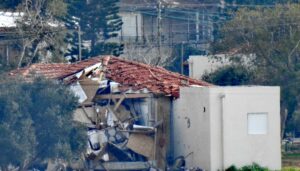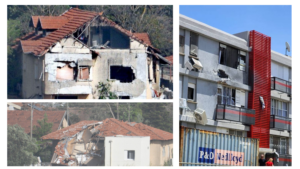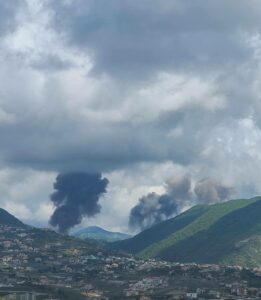Although the year 2022 has been branded the ‘year of Iran’ in the Israeli Air Force due to alarming advances in its nuclear program, the Israeli defense establishment is still fixated on gradually building up new air and ground capabilities in order to upgrade Israel’s readiness for its top conventional military, the one that comes from Hezbollah in Lebanon.
The Shi’ite, Iranian-backed Hezbollah has placed most of its infrastructure in southern Lebanese villages, where it maintains a stronghold. It has deployed an arsenal of some 150,000 projectiles in civilian areas, built fortifications and posts in the villages, as well as in southern Beirut and the eastern Beka’a Valley, and dug a network of underground bunkers, creating significant intelligence challenges for the IDF.

This reality forces Israel to be precise and swift during the next conflict.
The IDF’s force build-up process is heavily influenced by its new operational concept, dubbed ‘Victory.’ This concept is itself is the basis for the IDF’s five-year Momentum multi-year plan, which started being implemented in 2020, and it will remain in effect until 2024.
The capabilities described below will take years to build, and will not appear overnight. But they represent some of the central objectives of the IDF’s branches in the coming years, and where a large share of the defense budget is going towards.
In drawing up these objectives, the IDF General Staff team, called ‘IDF 2030,’ was asked in 2019 to think ten years ahead and imagine how the region would look like. It divided its results into three ‘colors. The red part of the analysis thought about where Israel’s enemies are headed, the blue part looked at where the IDF needs to be, and the white zone looked at the changing strategic and tactical environment.
The red team had to think about who the enemies will be facing Israel in 2030, what weapons they will be armed with, how they will be connected to one another, and whether the Iranian axis will still form the chief adversary – and if not, what would replace it. The blue team examines military force build-up, Israeli budgetary scenarios, the national economic situation of the future, and the social winds that will shape the country. The white team took note of the miniaturization of technology, the growth of precision strike firepower and its proliferation, and the rapid spread of urban warfare in the world and the Middle East.
As part of this planning, the IDF formed 30 teams that dissected the IDF in a fundamental manner, highlighting gaps and diagnosing current capabilities.
Later, the former head of the Operations Directorate (and current head of Military Intelligence), Maj. Gen. Aharon Haliva led the formulation of a new force activation concept – ‘Victory.’
According to this concept, every day that war is shortened holds huge significance, since the Israeli home front will be under massive enemy projectile fire. Shortening the length of a conflict, therefore, became a key objective. The second objective of Momentum is to build a military machine that completes a war with minimal cost of lives to Israel, and the third objective is to do so at a minimal economic cost.
The groundwork for Momentum then led to the drawing up of more detailed force build-up capabilities for the Ground Forces, Navy, and Air Force.
Field battalions are being built with the aim of injecting them with real-time relevant intelligence and precision firepower to match that intelligence. A digital combat network must serve companies, battalions, brigades, and divisions in the field, and enable headquarters to manage the battle arena efficiently.
The network is also being developed to connect the ground, air, and sea forces into a single war machine, which can send and receive huge numbers of targets to its various components, and complete sensor to shooter cycles in seconds.
According to this program, an IDF company commander will have his own UAVs, a digital network to communicate with tanks and helicopters, and the ability to active electromagnetic spectrum and cyber units.
New generation ground armored vehicles will enjoy active defense systems (Trophy), enabling them to intercept threats like anti-tank missiles in time, and to expose the location of Hezbollah cells in real-time, returning fire in seconds. Increasingly automated capabilities on-board vehicles will take the workload off personnel inside, enabling them to focus on managing the combat from within closed hatches.
An intelligence factory for waves of airstrikes
The air force, meanwhile, got to work on building new definitions of air superiority. Part of that superiority involves building up a very large target bank ahead of time – ‘offline’ – prior to the start of the conflict, and then matching that intelligence with the ability to rain down thousands of precise air-to-ground munitions per 24 hours.
The use of Artificial Intelligence systems is speeding up the conversion of raw data into actionable intelligence, as data streams in from many kinds of sensors. These include radars, advanced cameras, electronic and signals intelligence, and satellite monitoring. New systems are coming online for fusing all of this intelligence into a single picture.
The recent creation of an IDF Target Directorate, which kicks into action during combat and produces real-time targets, means the pace of fire can continue to be high without running out of targets too soon, as has occurred in past conflicts.
This would mean that in theory, the air force could launch an opening strike five to ten times larger than, say the 2006 Second Lebanon War, and then keep the momentum high well into the conflict.
The ability to digitally connect all firepower assets to intelligence assets is a key pillar of the Momentum vision.
The IAF is working continuously to improve its detection of low observable targets, while also working on its ability to deal with the growing threat of suicide UAVs, cyber attacks against its air defense systems, and the likely presence of advanced Iranian surface-to-air missile systems in the northern arena, be it Lebanon, Syria, or western Iraq.
The gradual increase in Hezbollah’s precision-guided missile arsenal means that IAF bases and runways will form a top priority target in any future war.
The IAF will need to be able to defend its assets in Israel, recover quickly when its air defenses fail and keep up a tempo of strikes on challenging urban and underground targets in Lebanon in a future war.
The growing number of F-35 stealth fighter jets, which can act as a trailblazer in any war, piercing air spaces that are crowded with enemy SAMs and sending back intelligence to fourth-generation F-16s and F-15s, will be a key force build-up objective for the IAF.
It is important to note that Israel has no desire or intention to launch a war. Yet the safety margins that in the past helped Israel and its radical Islamist adversaries avoid full-scale conflict are growing increasingly narrow with time.
*Featured photo courtesy of IDF Spokesperson’s Unit.







3 Responses
Mobile precision high-density submunitions launched by rockets are both more cost-effective and present less of a static counter-force target (to Hezbollah) than airbases and runways that can be temporarily disrupted.
Most rockets and missiles cannot acquire targets in real time, (those that can are very expensive) and many of Hezbollah precise missiles are mobile on civil trucks hidden in civil containers using shoot-and-scout tactics.
Also they are limited because of ballistic trajectory and many more disadvantages.
There are effective against surface stationary targets and deterrence mostly.
There is no real alternative to air power when it comes to heavy bombing and real time target selection.
what chance do we stand????